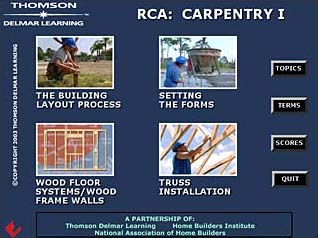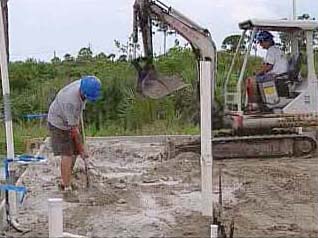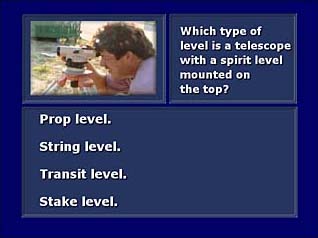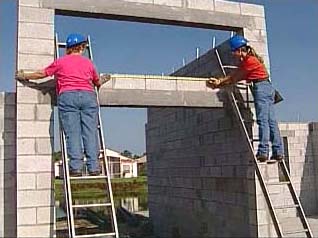Back to Course List
Building: RCA: Carpentry I

- Product ID
- dlmrrcc1
- Training Time ?
- 127 to 254 minutes
- Language(s)
- English
- Video Format
- Standard Definition
- Required Plugins
- MasteryNet Player
- Lesson Interactions
- 14
- Quiz Questions
- 39



Overview
This training is the first of a two part series, which covers everything from the basics of obtaining the building permit to the detail work of interior trim. Special geographic considerations are addressed in order to more accurately reflect building practices throughout the U.S., and features such as "Carpenter’s Tips," and "Safety Tips" provide practical advice from the experts.
![]() This course is in the Advantage™ format, to read about Advantage™ features click here.
This course is in the Advantage™ format, to read about Advantage™ features click here.

- Install on any SCORM LMS
- Rich multimedia presentation with interactions and quiz
- Print certificate and wallet card
- You have 30 days to complete the course
Workplaces
Categories
Audience
This training is intended for anyone working as a carpenter or considering work as a carpenter.
Topics
The course presents the following topical areas:
- The Building Layout Process
- Setting The Forms
- Wood Floor Systems/Wood Frame Walls
- Truss Installation
Intended Performance Outcomes
Upon successful completion of this course you will be better prepared to:
-
Follow the building layout process.
- Recognize the plot plan as the reference for finding setback distances.
- Choose the transit level to find accurate elevation readings.
- Explain the benefits of keeping both eyes open while sighting through a transit.
- Recall the formula of the pythagorean theorem.
- Describe the composition of a batter board.
- Identify an example of water level.
- Define a laser level.
- Interpret the sensor tone of an audible sensor of a laser level.
- Choose the proper process used to measure string dimensions.
- Recognize when a water level is not accurate.
-
Properly set forms.
- Define rebars.
- Describe the placement of a monolithic slab.
- Name additional supports of support stakes.
- Explain the process used to protect plumbing and utility pipes from direct contact with cement.
- Recognize when polyethylene is put down before concrete placement.
- Assess the number placed in front of the word or symbol for steel on the plans.
- Name the small pieces of wire that tie rebars into position.
- Define PSI.
- Explain how a cold joint happens.
-
Properly install wood floor systems and frame walls.
- Name typical wood used for a mud sill.
- Define a sill sealer.
- Recall the formula for joint spacing.
- Identify the definition of a girder.
- Choose the framing square to lay out custom cross bridging.
- Calculate the amount of space to leave between sub flooring panels.
- Define a soleplate.
- Characterize a rough opening.
- Describe connectors.
- Recall the number of people needed to lift a pre-assembled wall.
-
Properly install a truss.
- Define odd space.
- Describe a scissors truss.
- Identify the purpose of a truss drawing or layout.
- Select the proper distance a portable ladder must extend above the landing surface.
- Choose proper fastening procedures when plying trusses together.
- Identify safety procedures when using pneumatic nailers.
- Choose the process a signal person uses when lowering the boom and raising the cable.
- Name a type of bracing for trusses.
- Analyze information given from truss engineering diagrams.
- Identify when a T brace can be used.
© Mastery Technologies, Inc.



